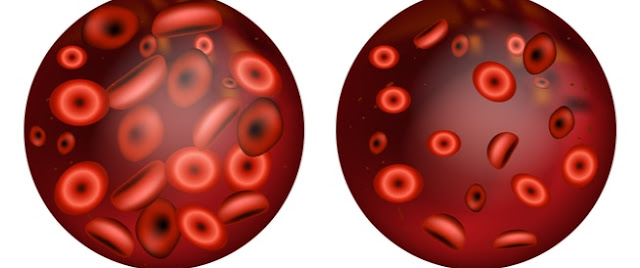Causes and risk factors that lead to anemia | healthy care
Causes and risk factors that lead to anemia
Causes and risk factors for anemia
The blood consists of a liquid called "plasma" (plasma/plasma) - and a group of cells that divide into three types.
| --- | Leucocytes: These cells fight infection.
| --- | Platelet / Thrombocyte: These cells help blood clot after infection.| --- | Erythrocytes: These cells carry oxygen from the lungs, through the blood flow, to the brain, other vital organs, and tissues in the body.
The importance of hemoglobin
| --- | Hemoglobin enables red blood cells to transfer (carry) oxygen from the lungs to the rest of the body and transfer carbon dioxide from the body, back, to the lungs, so that it can be expelled from the body in the exhalation process.
| --- | Most blood cells, including red blood cells, are constantly produced in the marrow (Bone marrow), which is a red spongy substance found inside the large bone cavities in the body.
| --- | In order to produce hemoglobin and red blood cells, the body needs iron, other minerals, vitamins, and proteins that are available in human food. In addition to some hormones, the most important of which is the hormone Erythropoietin (EPO), which the kidneys secrete in order to produce red blood cells.
| --- | It should be noted that the average life of a red blood cell ranges from 110 to 120.
| --- | When a person suffers from anemia, his body does not produce enough red blood cells, but rather wastes many of them or damages them faster than its ability to produce new blood cells.
Types of anemia
| --- | Iron deficiency anemia: This common type of anemia affects approximately 2-3% of the US adult population. The reason for its occurrence is the lack of iron in the body. Because the bone marrow needs iron in order to produce hemoglobin, and if the supply of iron is not sufficient, the body will not be able to produce enough hemoglobin for red blood cells.
| --- | Vitamin Deficiency Anemia: In addition to its need for iron, the body also needs folic acid and Vitamin B12 to produce a sufficient amount of the correct red blood cells. A diet lacking one of the vital nutritional compounds can lead to reduced red blood cell production. There are some people who suffer from the inability of their bodies to absorb vitamin B-12 effectively.
| --- | Anemia as a symptom of chronic disease: many chronic diseases, such as cancer, Cancer, AIDS, gout, Crohn's disease, and other chronic inflammatory diseases, can affect the production of Red blood cells, thereby causing chronic anemia. Kidney failure can also lead to anemia.
| --- | Aplastic anemia: This type of anemia is very rare, but it is life-threatening. It occurs as a result of the reduced ability of the bone marrow to produce the three types of blood cells (red, white blood cells, and platelets). The cause of aplastic anemia remains unknown in most cases. However, it is believed that it has something to do with diseases affecting the immune system.
| --- | Anemia caused by a bone marrow disease: Many diseases, such as leukemia, myeloid dysplasia (Myelodysplasia) are a previous medical condition of leukemia and can lead to the appearance of anemia and affect the marrow
The bone. Effects of precancerous or semi-precancerous disorders, these can range from a very mild change in the amounts of blood cell production to the complete cessation of production in a way that is life-threatening. There are also other types of cancer that attack the blood and bone marrow, such as multiple myeloma, myeloproliferative disorders, and lymphoma.
| --- | Hemolysis Anemia: This group of types of anemia develops when red blood cells are destroyed more quickly than the bone marrow's ability to produce new blood cells.
Infection with some diseases: There are certain blood diseases that can cause extensive red blood cell damage. Disturbances in the immune system can prompt the body to produce antibodies against red blood cells, causing them to be destroyed prematurely. Also, take medications
Certain, as different types of antibiotics (Antibiotics) used to treat different types of infections (infections), can also damage red blood cells.
| --- | Sickle cell anemia: This type of anemia is sometimes severe, inherited, and in most cases affects people of African, Arab or Mediterranean descent. This type of anemia occurs as a result of a hemoglobin imbalance that makes red blood cells an exceptional sickle-like shape. This form of a red blood cell causes these cells to atrophy and die prematurely, thus causing a chronic deficiency in red blood cells.



















No comments